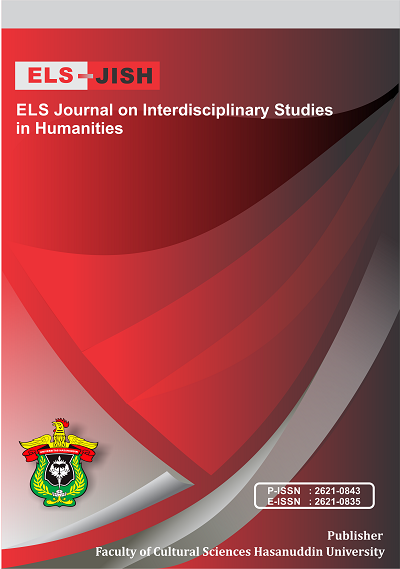Institutionalization, Organizational Commitment, and Hope for Personal Fulfillment in The Shawshank Redemption
DOI:
https://doi.org/10.34050/elsjish.v5i4.23163Keywords:
Institutionalization, Organizational Commitment, Hope, Personal FulfillmentAbstract
Institutionalization is a socialization process through which the values, beliefs, policies, and practices of an organization are instilled within the members of that organization that they might collectively adopt these values or rules and commit themselves to that organization. However, those being institutionalized under authoritarian discipline may lose the freedom of their soul and a personal level of self. In order to raise readers’ awareness of the impact of institutionalization and commitment on the individual or collective actors, this study intends to use the film The Shawshank Redemption as a case study, using content analysis as a qualitative research technique to analyze the symbolic scenes in the film in order to reveal how commitment and stability via institutionalization can be brought into the organization. To achieve this goal, the study uses Scott’s institutional theory and Meyer and Allen’s organizational commitment model to demonstrate how commitment may greatly impact people. Those being institutionalized, like Brooks in The Shawshank Redemption, may lose their ability to think and act independently and thus lose their hope for fulfillment. However, those like Andy and, later, Red, choosing to hold on to freedom of the soul and a personal level of self, can deinstitutionalize themselves; break free of the shackles, either physically or spiritually, of the organization; and make a commitment toward their own inner development.
References
Busenitz, L. W., Gómez, C., & Spencer, J. W. (2000). Country Institutional Profiles: Unlocking Entrepreneurial Phenomena. Academy of Management Journal, 43, 994–1003.
Cakı, N., Asfuroglu, L., & Erbas, O. (2015) The Relationship between the Level of Attachment in Romantic Relations, Affective Commitment and Continuance Commitment towards Organization: A Field Research. Procedia Economics and Finance, 26, 1007 – 1013.
Creswell, J. W. (2007). Qualitative Inquiry and Research Design: Choosing among Five Approaches. Thousand Oaks, CA: Sage.
Darabont, F. (1994). The Shawshank Redemption [film]. Beverly Hills, CA: Castle Rock Entertainment.
Eslami, J., & Gharakhani, D. (2012), Organizational Commitment and Job Satisfaction. ARPN Journal of Science and Technology, 2(2), 85-91.
Jaber, T. (2021). A Surge toward a Sustainable Future: Organizational Change and Transformational Vision by an Oil and Gas Company. Revista de Administração Contemporâne, 25(3), e200031. https://doi.org/10.1590/1982-7849rac2021200031.en.
King, S. (1982). Rita Hayworth and Shawshank Redemption. In S. King, Different seasons (pp. 3-101). New York: Viking Press.
Kostova, T. (1997). Country Institutional Profiles: Concept and Measurement. Academy of Management Proceedings, 1997(1), 180–184.
Lawrence, T. B., & Suddaby, R. (2006), Institutions and Institutional Work. In Clegg, S., Hardy, T., Lawrence, T., and Nord, W. (Eds), The SAGE Handbook of Organizational Studies (pp. 215-254. London: Sage. Merriam, S. B., & Tisdell, E. J. (2015). Qualitative Research: A Guide to Design and Implementation. San Francisco, CA: John Wiley & Sons.
Meyer, J. W., & Rowan, B. (1977). Institutionalized Organizations: Formal Structure as Myth and Ceremony. American Journal of Sociology, 83(2), 340–363.
Meyer, J. P., & Allen, N. J. (1984). Testing the “Side-bet Theory” of Organizational Commitment: Some Methodological Considerations. Journal of Applied Psychology, 69, 372–378.
Meyer, J., & Allen, N. (1991). A Three-component Conceptualization of Organizational Commitment. Human Resource Management Review, 1(1), 61-89.
Meyer, J., Allen, N., (1997). Commitment in the Workplace, Theory, Research and Application. London: Sage.
Önda, O. (2014). Summary of Organizations and Organizing. Retrieved from https://www.academia.edu/42157091/Summary_of_Organizations_and_Organizing.
Peng, Y. U. (2020). An Interpretation of Influences of Institutionalization on the Fate of Characters in “The Shawshank Redemption.” English Language Teaching, 13(5), 11-14.
Scott, W. R. (1995). Institutions and Organizations. Foundations for Organizational Science. London: Sage .
Scott, W.R. (2002). Organizations: Rational, Natural, and Open Systems. Upper Saddle River, NJ: Prentice Hall.
Scott, W.R. (2008), Institutions and Organizations: Ideas and Interests (3rd ed.). Los Angeles, CA: Sage.
Scott, W. R. (2013). Institutions and Organizations: Ideas, Interests, and Identities (4th ed.). Los Angeles, CA: Sage.
Selznick P (1996). Institutionalism ‘Old’ and ‘New.’ Administrative Science Quarterly, 41(2), 270–277.
Shen, G. C., & Snowden, L. R. (2014) Institutionalization of Deinstitutionalization: a Crossnational Analysis of Mental Health System Reform. International Journal of Mental Health Systems, 8(47), 68–112.
Sibbald, S. L., Jiwani, A. A., & Martin, J. (2022) Recycling Quotes or Personal Plagiarism? A Methodological Contribution on Integrity in Qualitative Health Research. SSM-Qualitative Research in Health, 2, 100084.
Triguero-Sánchez, R., Peña-Vinces, J., & Ferreira, J. J. M. (2022). The effect of collectivism-based organisational culture on employee commitment in public organisations, Socio-Economic Planning Sciences, 101335. https://doi.org/10.1016/j.seps.2022.101335.
Veciana, J. M., & Urbano, D. (2008). The Institutional Approach to Entrepreneurship Research. Introduction. International Entrepreneurship and Management Journal, 4(4), 365–379.
Yucel, I, McMillan, A., Richard, O. C. (2014). Does CEO Transformational Leadership Influence Top Executive Normative Commitment? Journal of Business Research
Downloads
Published
Issue
Section
License
Copyright (c) 2022 Chia-Li Lin, Ya-huei Wang

This work is licensed under a Creative Commons Attribution-NonCommercial-ShareAlike 4.0 International License.






